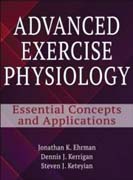
Advanced Exercise Physiology: Essential Concepts and Application
Ehrman, Jonathan
Kerrigan, Dennis
Keteyian, Steven
Advanced Exercise Physiology: Essential Concepts and Applications builds upon foundational topics and looks further into key physiological components to help advanced students gain a deeper level of understanding. Authors Jonathan K. Ehrman, Dennis J. Kerrigan, and Steven J. Keteyian address a wide range of complex topics with evidence-based information and a focused, targeted style. The first five chapters offer a detailed examination of the various body systems. The next two chapters focus on exercise testing and training principles, as well as training adaptations as they relate to aerobic power, anaerobic power, range of motion, and resistance training of healthy individuals and competitive athletes. The remaining chapters focus on a variety of topics, including athletic performance, body composition and weight management, and environmental influences of exercise physiology. The final two chapters bring a unique perspective to the book with a review of the relationship between exercise physiology and public health and a look at recent and emerging topics in the field, including genomics and pharmacology. Enhancing the content are learning aids, more than 140 images and illustrations, and practical examples from among clinical patients, healthy individuals, and competitive athletes. Key terms and their definitions appear at the end of each chapter; these help students understand key concepts and serve as a useful reference for practitioners. The appendixes contain information related to topics such as efficiency and energy expenditure, metabolic equivalent (MET) values of common activities, and the professionalization of exercise physiology. For instructors, Advanced Exercise Physiology also includes a test package and an image bank to assist with classroom lecture preparations. The ancillaries, in-text learning components, and comprehensive content combine to create an ideal text to be used in advanced courses in exercise physiology. Contents Preface Chapter 1: Exercise Metabolism Foundations of Metabolism Energy Transfer Energy Substrates for Metabolism Energy Systems Total Yield From Metabolism Metabolic Regulation During Exercise Factors That Influence Exercise Metabolism Summary Definitions Chapter 2: Dynamics of Skeletal-Neuromuscular and Gastrointestinal Physiology Structure of Skeletal Muscle and Mechanisms of Contraction Neuromuscular Control of Movement Functional Properties of Muscle Regulatory Control of the GI System Smooth Muscle Overview of the GI Organs Summary Definitions Chapter 3: Cardiovascular System: Function and Control General Anatomy of the Cardiovascular System Mechanisms of Contraction Cardiac Electrophysiology Conduction System and Electrocardiogram Coronary Blood Supply Cardiac Cycle and Mechanics Cardiac Performance Changes in Heart Rate, Stroke Volume, and Cardiac Output During an Acute Bout of Exercise Circulatory Hemodynamics and Distribution of Blood Flow Transport of O2 and CO2 Cardiorespiratory Fitness: The Whole Picture Cardiovascular Regulation Other Important Topics in Advanced Cardiovascular Exercise Physiology The Kidney and Exercise Summary Definitions Chapter 4: Pulmonary Exercise Physiology Lung Structure and Function Exercise and Lung Function Illness Summary Definitions Chapter 5: Immune and Endocrine System Immune System Components and Function Exercise and Immune Function Acute Exercise and the Immune Response Exercise Endocrinology Hormone Control of the Cardiorespiratory System During Aerobic Exercise Hormone Control of Substrate Availability During Aerobic Exercise Hormone Control of Fluid and Electrolyte Balance During Aerobic Exercise Hormone Response After Aerobic Exercise Training Endocrine Response During Anaerobic or Resistance Exercise Hormone Response During Acute Anaerobic Exercise Endocrine Adaptations to Anaerobic Exercise Training Summary Definitions Chapter 6: Principles for Testing and Training for Aerobic Power Work and Power Direct and Indirect Measurement of Energy Production Net O2 Cost of Exercise Caloric Equivalent of O2 Protocols for Assessing Aerobic Power Matching Training Regimen to Energy and Organ Systems and Training to Improve Aerobic Power Physiological Adaptations Attributable to Aerobic Training Summary Definitions Chapter 7: Principles for Testing and Training Anaerobic Strength, Power, and Range of Motion Anaerobic Exercise Training Principles Resistance Testing and Training Range of Motion Putting It All Together Summary Definitions Chapter 8: Body Composition and Weight Management Body Composition Models and Theories Weight Management Principles Summary Definitions Chapter 9: Performance: Environmental Stressors, Genetics, Nutrition, and Ergogenic Aids Exercise and the Environment Performance Exercise Physiology Summary Definitions Chapter 10: Physical Activity and Exercise for Health and Fitness Epidemiology of Physical Activity, Inactivity, and Exercise Relationship Between Physical Activity, Exercise, and Fitness and Disease Prevention Proper Screening Before Exercise and the Risks Associated With Exercise How Much Exercise Is Enough? Exercise in the Treatment of Common Noncommunicable Chronic Diseases Challenges of Exercise Adherence and Facilitating Behavior Change Summary Definitions Chapter 11: Emerging Concepts: Exercise Pharmacology and Exercise Genomics Exercise Pharmacology Exercise Genomics Summary Definitions Appendix A: Calculations for Oxygen Consumption and Carbon Dioxide Production Appendix B: Efficiency and Energy Expenditure Appendix C: Metabolic Equivalent of Task Values of Common Activities Appendix D: Professionalization of the Exercise Professional Appendix E: Common Scientific Abbreviations and Units References About the Authors Audiences Textbook for graduate-level students enrolled in advanced exercise physiology courses; professional reference book for personal trainers and other fitness practitioners.
- ISBN: 9781492505716
- Editorial: HUMAN KINETICS PUBLISHERS
- Encuadernacion: Rústica
- Páginas: 384
- Fecha Publicación: 01/11/2017
- Nº Volúmenes: 1
- Idioma:
